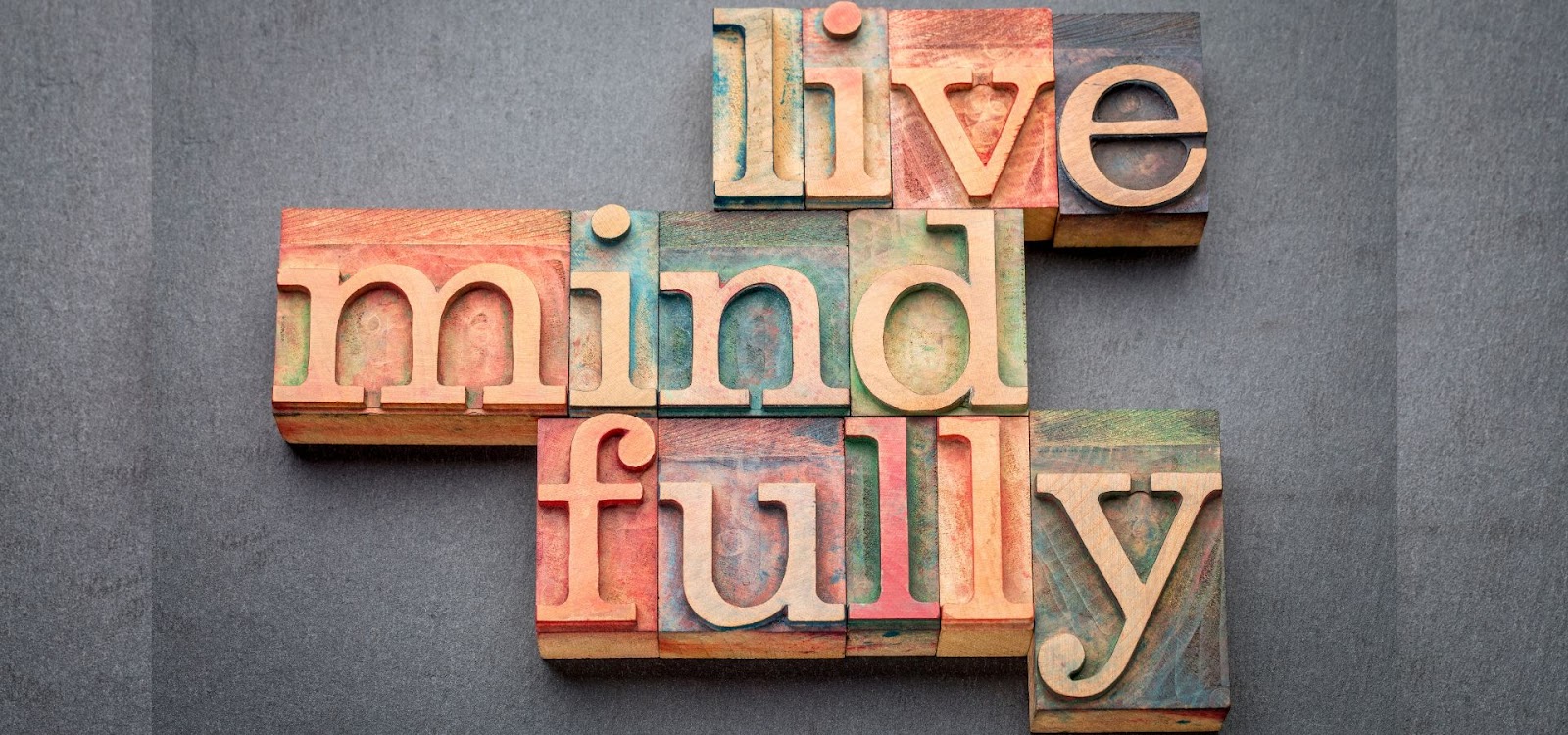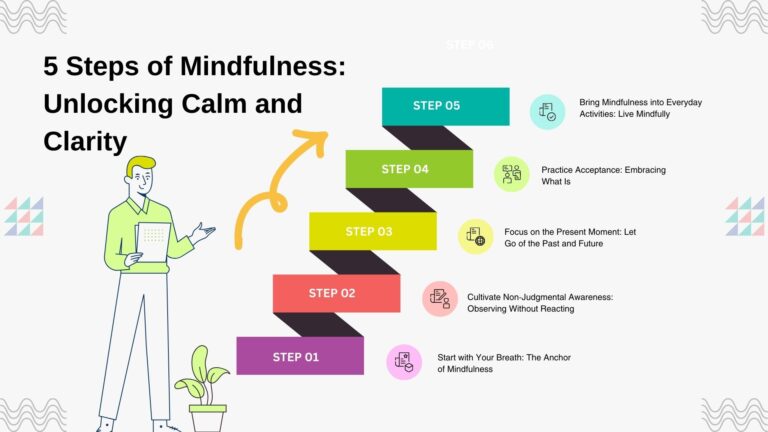In the hustle and bustle of modern life, mindfulness offers a path to inner peace, clarity, and emotional balance. By learning to stay present and aware of each moment, mindfulness helps us break free from stress, anxiety, and the endless distractions that clutter our minds. Whether you’re a beginner or someone looking to deepen your practice, these five steps of mindfulness can guide you toward a more peaceful and focused life.

1. Start with Your Breath: The Anchor of Mindfulness
The first and most essential step in mindfulness is learning to focus on your breath. Breathing is something we do naturally, but when practiced mindfully, it becomes a powerful tool to bring your awareness to the present moment.
How to Practice Mindful Breathing:
- Sit in a comfortable position with your spine straight and shoulders relaxed.
- Close your eyes and take a deep breath in through your nose, feeling your chest and abdomen expand.
- Slowly exhale through your mouth, letting go of any tension.
- Focus on the sensation of your breath coming in and out, and if your mind starts to wander, gently bring your attention back to your breath.
Focusing on your breath helps anchor your attention and keeps you grounded. Even a few minutes of mindful breathing can lower stress and anxiety levels, creating a sense of calm and clarity.
2. Cultivate Non-Judgmental Awareness: Observing Without Reacting
One of the core principles of mindfulness is non-judgmental awareness. This means observing your thoughts, emotions, and physical sensations without labeling them as “good” or “bad.” Instead, you simply notice them as they are.
How to Practice Non-Judgmental Awareness:
- Pay attention to your thoughts and feelings as they arise throughout the day.
- If you notice yourself feeling anxious or stressed, don’t try to push the emotion away or fix it. Instead, acknowledge it: “I’m feeling anxious right now.”
- Avoid judging yourself for having these thoughts or feelings. Just observe them with curiosity, as if you were a neutral bystander.
This practice can be incredibly liberating. It helps you break the cycle of overthinking and emotional reactivity, creating space for a calmer and more balanced response to life’s challenges.

3. Focus on the Present Moment: Let Go of the Past and Future
Mindfulness teaches us to focus on the present moment. Often, our minds are preoccupied with worries about the future or regrets about the past. In doing so, we miss the richness of the present.
How to Stay Present:
- Throughout the day, pause to notice your surroundings. What do you see, hear, or feel right now?
- When you’re eating, focus entirely on the taste, texture, and smell of your food, rather than multitasking or rushing through the meal.
- When you’re walking, pay attention to the sensation of your feet hitting the ground and the rhythm of your steps.
By staying present, you become more aware of your experience and learn to appreciate the small moments that often go unnoticed.
4. Practice Acceptance: Embracing What Is
Mindfulness isn’t about trying to change or control your experiences. Instead, it’s about accepting things as they are in the present moment, even if they are uncomfortable or challenging. This doesn’t mean resignation or giving up, but rather allowing things to be as they are without resistance.
How to Practice Acceptance:
- When faced with a difficult situation, instead of immediately reacting, take a moment to acknowledge how you feel. For example, you might say, “This is difficult right now, and that’s okay.”
- Recognize that everything—positive or negative—is temporary, and resisting the present moment often creates more tension.
- Acceptance doesn’t mean you won’t take action to improve things, but it allows you to approach challenges with a clearer mind and less emotional turmoil.
Acceptance fosters resilience and emotional balance, helping you navigate life’s ups and downs with greater ease.

5. Bring Mindfulness into Everyday Activities: Live Mindfully
The final step in mindfulness is integrating it into your everyday life. Mindfulness isn’t limited to meditation or sitting quietly; it can be practiced in every aspect of your daily routine.
How to Live Mindfully:
- Mindful Eating: When you eat, savor each bite and focus entirely on the act of eating. Pay attention to the flavors, textures, and smells of your food.
- Mindful Walking: As you walk, bring your awareness to the sensation of your feet hitting the ground and the rhythm of your breath.
- Mindful Listening: In conversations, practice listening fully without interrupting or thinking of what you’ll say next. Give your full attention to the other person.
- Mindful Breaks: Throughout the day, take short breaks to focus on your breath, stretch, or simply observe your surroundings with full attention.
By bringing mindfulness into everyday activities, you develop a greater sense of presence and appreciation for the small, often overlooked moments of life.
Conclusion
Mindfulness is a journey of self-awareness and acceptance. By following these five steps—focusing on your breath, cultivating non-judgmental awareness, staying present, practicing acceptance, and integrating mindfulness into daily life—you can unlock a deep sense of calm and clarity. These practices help you stay grounded, improve emotional resilience, and bring a greater sense of purpose and fulfillment to your life.
Whether you’re just starting out or looking to deepen your mindfulness practice, these steps offer a simple yet profound way to navigate the complexities of modern life with greater ease and inner peace.
FAQs
Do I need to meditate to be mindful?
No, mindfulness can be practiced in everyday activities without the need for formal meditation. Mindful breathing, walking, or eating are examples of informal mindfulness practices.
How long does it take to see benefits from mindfulness?
Many people notice benefits, such as reduced stress and increased focus, after just a few weeks of consistent practice. However, the long-term benefits grow with regular practice.
Can mindfulness help with anxiety?
Yes, mindfulness has been shown to reduce symptoms of anxiety by helping individuals stay present and less consumed by anxious thoughts about the future.
How often should I practice mindfulness?
You can practice mindfulness at any time throughout the day. Even a few minutes of mindful breathing or observing your surroundings can make a significant difference.


